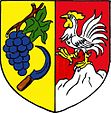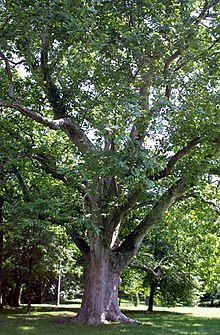Skalice u Znojma
| Skalice | ||||
|---|---|---|---|---|
|
||||
| Basic data | ||||
| State : |
|
|||
| Region : | Jihomoravský kraj | |||
| District : | Znojmo | |||
| Area : | 947.3611 ha | |||
| Geographic location : | 48 ° 58 ' N , 16 ° 13' E | |||
| Height: | 230 m nm | |||
| Residents : | 512 (Jan. 1, 2019) | |||
| Postal code : | 671 71 | |||
| License plate : | B. | |||
| traffic | ||||
| Street: | Hostěradice - Višňové | |||
| structure | ||||
| Status: | local community | |||
| Districts: | 1 | |||
| administration | ||||
| Mayor : | Rudolf Křepela (as of 2016) | |||
| Address: | Skalice 92 671 71 Hostěradice |
|||
| Municipality number: | 594768 | |||
| Website : | www.skaliceuznojma.cz | |||
Skalice (German Skalitz , 1939–45 Golitz ) is a municipality in the Czech Republic . It is located twelve kilometers southwest of Moravský Krumlov and belongs to the Okres Znojmo .
geography
Skalice is located on the southeastern slope of the Jevišovická pahorkatina ( Jaispitzer hill country ) in the valley of the brook Skalička ( Skalitz brook ). To the north rise the Žlíbky (341 mnm) and in the east the Kopec (253 mnm). State road II / 400 runs on the southern outskirts between Hostěradice and Višňové .
Neighboring towns are Džbánice and Vémyslice in the north, Dobelice , Petrovice , Lesonice , Kadov and Miroslavské Knínice in the Northeast, Mišovice the east, Hostěradice and Chlupice the southeast, Oleksovice , Stošíkovice na Louce and Vítonice in the south, Želetice and Morašice in the southwest and Višňové and Trstěnice in the north-west.
history
Archaeological finds prove the presence of people in the municipality since the Paleolithic . Permanent settlement began in the Neolithic .
In the middle of the 13th century the village belonged to the possessions of the Znojmo burgrave Boček of Jaroslavice and Zbraslav . The place name derives from the rocky bottom of the Skalička northwest of the village. The first documentary mention of Skalice was in 1252 when Boček von Jaroslavice donated the third part of the wine tithing from the village to the newly founded Žďár monastery. At that time in Skalice there was a church dedicated to St. Vitus chapel. In 1348 a part of the village belonged to Gallus von Trmačov, in 1367 Jakob von Trmačov was mentioned as the owner. In 1375 Ulrich and Drahoslav von Lhota sold a Freihof in Skalice to Artleb von Zezurka and Obora, who in 1397 sold the entire village to Wiknan von Kaniowitz. In 1412 the brothers Bohunek and Konrad used the Skalice label . In 1419 Niklas von Kalub prescribed his wife income from the villages of Skalice and Újezd . The village of Kravky north of Skalice became extinct in the 15th century. The subsequent owners of the estate were Johann von Skalice around 1459, Adam von Skalice around 1466, and then the Bohemian Marshal Johann von Leipa , who sold Skalice together with the Slatina estate to Hynek Jankovský von Wlaschim in 1530 . This probably had a fortress built as his seat. Hynek's heir, Heinrich von Wlaschim, had the Skalice estate with a farm assigned to Dorothea von Mštěnice in the land table in 1546 . Ten years later, Dorothea's eldest sons Albrecht and Wenzel inherited the Skalice estate with the desolate Lyšanovský farm; the Freihof disappeared completely at the end of the 16th century.
From 1564 the Skalice estate belonged to Heinrich / Jindřich (V.) ( occupied 1542–1567 ) Zajímač von Kunstadt-Jaispitz , who gained the title of Skalice from that time , and from 1601 to Heinrich Žalkovský from Žalkovice. In 1633 Friedrich von Wlaschim bought the Skalice estate including the castle on Bítov and Jemnice and united it with Slatina. In 1687 Maximilian Ernst Baron Jankovsky von Vlasching (1665–1736), who was later raised to the rank of count, inherited the property from his father of the same name. The daughters Marie Anna Leopoldina (1696–1734) and Maria Johanna (1701–1752) sprang from his marriage to Katharina Countess von Lamberg . With his death, the Jankovsky von Vlasching family died out in the male line. Maximilian Ernst's daughter Leopoldina inherited the goods Slatina and Skalice, who was married to Field Marshal Heinrich Dietrich Martin Joseph Graf Daun . Subsequently, a dispute broke out among the relatives about the family inheritance, which was decided in 1755 by the Bohemian Queen Maria Theresa in favor of Count Daun. In the same year Leopoldina's son Maximilian Franz Xaver Count Daun took over the estate; In 1788 his son Johann inherited it. After he died in 1795, the goods Bítov, Skalice, Horní Kounice , Horní Slatina and Slatina fell to his underage brother Franz de Paula Josef († 1836). In 1805 and 1809 the village was sacked by French troops. At the beginning of the 19th century the official seat was moved from Skalice to Horní Kounice. In 1837 Franz de Paula's son Heinrich Graf von Daun inherited the property. The Counts of Daun mainly farmed sheep here.
In 1834, the one with the goods included Latin , Upper Kaunitz , Allingau , Röschitz , Chlupitz , Kordula and Biskupitz associated allodial Skalitz a floor space of 1,453 square fathoms yoke 767. On average, 351 buckets of wine were produced annually on Gut Skalitz , and the cultivation of fruit and nuts was also important. The village of Skalitz or Skalice consisted of 79 houses with 418 Moravian-speaking inhabitants. In the village there was a newly built castle with a chapel, an aristocratic yard, a brandy house, a school and a mill. The parish was Hosterlitz . Up to the middle of the 19th century, Skalitz and Chlupitz formed an allodial property, the place of the combined goods was the market in Ober-Kaunitz.
After the abolition of patrimonial , Skalice / Skalitz formed a municipality in the judicial district of Hrottowitz from 1849. In 1868 the community became part of the Kromau district. The inhabitants lived from agriculture and viticulture. Since the income of the small peasant farms was insufficient, mother-of-pearl buttons were made at home. During the season, Slovak farm laborers also worked on the estate of the Counts of Daun for a deputation , the accommodation built for them (house no. 130) was popularly called Kasárna . With the death of Ottokar Graf von Daun, the family of the Counts of Daun died out in the male line in 1904. On the basis of a family inheritance contract , the goods fell to the four children from the marriage of Bertha von Daun († 1856) and Karl Wilhelm von Haugwitz , who, however, could not agree on the division of the inheritance and leased the goods. Up until the beginning of the 20th century there was an increasing influx of German-speaking populations.
After the First World War , the multi-ethnic state Austria-Hungary disintegrated and in 1918 the community became part of the newly formed Czechoslovak Republic . In the 1920s, the Haugwitz family sold the Skalice estate to Heinrich von Baratta-Dragono. Due to mismanagement, he had to sell almost all goods, so that only the Skalice estate, which had been reduced in size by the land reform, remained. The production of mother-of-pearl buttons ceased in the 1930s.
After the Munich Agreement, Skalice remained with Czechoslovakia in 1938 and was incorporated into the Okres Moravské Budějovice. During the German occupation , the community was given the German name Golitz in 1939 . Until 1945 the community was on the border with the German Empire. In Golitz a German school was set up in the German children were enrolled from the surrounding villages protectorate. On May 8, 1945, the Red Army occupied the village. After the end of the Second World War, Skalice became part of the Okres Moravský Krumlov again. Heinrich von Baratta-Dragono was expropriated in 1945. The German residents were expelled to Bavaria . Some of the Czechs left Skalice and moved to the evacuated villages in the border area. In 1949 a JZD was formed. In the following time numerous single-family houses were built in Skalice; the JZD had two two-story apartment blocks built.
In the course of the abolition of the Okres Moravský Krumlov, Skalice was assigned to the Okres Znojmo in 1961. In 1976 Morašice and Skalice merged. In 1990 Morašice broke away from Skalice and formed its own municipality again. In 2005 an extension of the school was completed, which houses a kitchen, dining room and gym.
Attractions
- Skalice Castle with the Chapel of St. Veit, it is mentioned for the first time in the stately accounts from the years 1633–1657. Before that, a fortress built by the Jankovský von Wlaschim lords in the 1st half of the 16th century probably stood on its place. The four-wing, single-storey building with a rectangular floor plan had 25 rooms. Between 1831 and 1839 Count Franz Daun had the palace rebuilt in Empire style into the summer residence of the Vöttau rulers , but he did not live to see the completion. The old castle chapel was demolished and a new chapel was built, which is integrated into the north wing. In 1945 the castle was expropriated from the property of Heinrich von Baratta-Dragono and transferred to the community. In the following time the castle was stripped of all of its interior fittings. In 1954, the Česká katolická charita acquired the building and set up a home for old women in it. In 1960 the castle was placed under the administration of the district national committee . In 1993 the old people's home was spun off from state administration. The structure has been repaired and modernized since the 2000s. It is protected as a cultural monument and not open to the public.
- Castle park, it has an area of 3 hectares and is freely accessible. The park is dominated by the 35 m high Skalicer plane tree, also common ash trees, mighty American Gleditschien and rare shrubs grow there. In front of the castle, at the end of a linden tree avenue in the park, there is a stone fountain from the 2nd half of the 18th century with two dolphin figures. In the park there is also a brick grotto with a figure of the Virgin Mary of Lourdes.
- Statue of St. John of Nepomuk on the outskirts, it dates from the 18th century
- Statue of St. John of Nepomuk in the village, created in the 19th century
- Chapel to the east above the village on the Kopec hill, it was built in the 19th century by the farmer Rabl
- Bell tower on the village pond
- Exhibition of historical fire extinguishers in the fire station
- Granary on the hill north of Skalice, the mighty structure was built at the beginning of the 19th century
- The Skalička valley above Skalice, at the confluence of the Trstěnický potok, the brook breaks a geological fault at the foot of a rock face
- Several crossroads
Web links
Individual evidence
- ↑ http://www.uir.cz/obec/594768/Skalice
- ↑ Český statistický úřad - The population of the Czech municipalities as of January 1, 2019 (PDF; 7.4 MiB)
- ^ Gregor Wolny : The Margraviate Moravia topographically, statistically and historically described , III. Volume: Znaimer Kreis (1837), pp. 512-522
- ↑ http://www.skaliceuznojma.cz/?q=node/13





